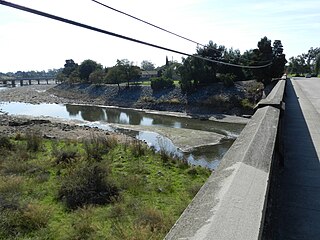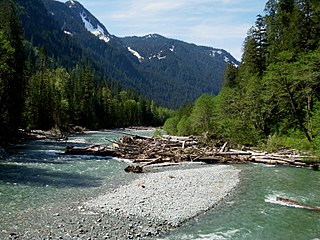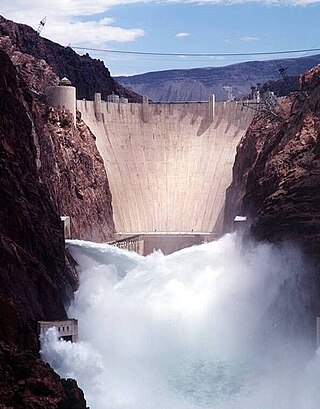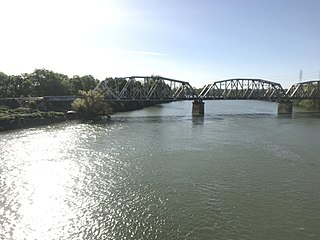
The Cowlitz River is a river in the state of Washington in the United States, a tributary of the Columbia River. Its tributaries drain a large region including the slopes of Mount Rainier, Mount Adams, and Mount St. Helens.

Priest Rapids Dam is a hydroelectric, concrete gravity dam; located on the Columbia River, between the Yakima Firing Range and the Hanford Nuclear Reservation, and bridges Yakima County and Grant County, in the U.S. state of Washington. The dam is 24 miles south of the town of Vantage, and 47 miles northwest of the city of Richland. It is located at mile marker 397.1 from the mouth of the Columbia. It is owned by the Grant County Public Utility District (PUD). Priest Rapids, for which the dam was named, are now submerged beneath the dam's reservoir.

The Santa Clara River is an 83 mi (134 km) long river in Ventura and Los Angeles counties in Southern California. It drains parts of four ranges in the Transverse Ranges System north and northwest of Los Angeles, then flows west onto the Oxnard Plain and into the Santa Barbara Channel of the Pacific Ocean.

The White River is a white, glacial river in the U.S. state of Washington. It flows about 75 miles (121 km) from its source, the Emmons Glacier on Mount Rainier, to join the Puyallup River at Sumner. It defines part of the boundary between King and Pierce counties.

The Dosewallips River is a river situated on the Olympic Peninsula in the U.S. state of Washington. It rises near Mount Anderson in the Olympic Mountains within Olympic National Park and drains to Hood Canal and thence to the Pacific Ocean.
Steelhead, or occasionally steelhead trout, is the common name of the anadromous form of the coastal rainbow trout (Oncorhynchus mykiss irideus) or Columbia River redband trout. Steelhead are native to cold-water tributaries of the Pacific basin in Northeast Asia and North America. Like other sea-run (anadromous) trout and salmon, steelhead spawn in freshwater, smolts migrate to the ocean to forage for several years and adults return to their natal streams to spawn. Steelhead are iteroparous, although survival is approximately 10–20%.

The Skokomish River is a river in Mason County, Washington, United States. It is the largest river flowing into Hood Canal, a western arm of Puget Sound. From its source at the confluence of the North and South Forks the main stem Skokomish River is approximately 9 miles (14 km) long. The longer South Fork Skokomish River is 40 miles (64 km), making the length of the whole river via its longest tributary about 49 miles (79 km). The North Fork Skokomish River is approximately 34 miles (55 km) long. A significant part of the Skokomish River's watershed is within Olympic National Forest and Olympic National Park.

Tacoma Power is a public utility providing electrical power to Tacoma, Washington and the surrounding areas. Tacoma Power serves the cities of Tacoma, University Place, Fircrest, and Fife, and also provides service to parts of Steilacoom, Lakewood, and unincorporated Pierce County. It is a division of the Tacoma Public Utilities and owns the Click! Network, developed by Steven Klein, Tacoma Power's former superintendent.

Lake Oroville is a reservoir formed by the Oroville Dam impounding the Feather River, located in Butte County, northern California. The lake is situated 5 miles (8 km) northeast of the city of Oroville, within the Lake Oroville State Recreation Area, in the western foothills of the Sierra Nevada. Known as the second-largest reservoir in California, Lake Oroville is treated as a keystone facility within the California State Water Project by storing water, providing flood control, recreation, freshwater releases to assist in controlling the salinity intrusion into the Sacramento-San Joaquin Delta and protecting fish and wildlife.

Alameda Creek is a large perennial stream in the San Francisco Bay Area. The creek runs for 45 miles (72 km) from a lake northeast of Packard Ridge to the eastern shore of San Francisco Bay by way of Niles Canyon and a flood control channel. Along its course, Alameda Creek provides wildlife habitat, water supply, a conduit for flood waters, opportunities for recreation, and a host of aesthetic and environmental values. The creek and three major reservoirs in the watershed are used as water supply by the San Francisco Public Utilities Commission, Alameda County Water District and Zone 7 Water Agency. Within the watershed can be found some of the highest peaks and tallest waterfall in the East Bay, over a dozen regional parks, and notable natural landmarks such as the cascades at Little Yosemite and the wildflower-strewn grasslands and oak savannahs of the Sunol Regional Wilderness. After an absence of half a century, ocean-run steelhead trout will soon be able to return to Alameda Creek to mingle with remnant rainbow trout populations. Completion of a series of dam removal and fish passage projects, along with improved stream flows for cold-water fish and planned habitat restoration, will improve and restore habitat conditions for migratory fish. Steelhead trout and Chinook salmon will soon be able to access up to 20 miles (32 km) of spawning and rearing habitat in Alameda Creek and its tributaries.

The Baker River is an approximately 30-mile (48 km), southward-flowing tributary of the Skagit River in northwestern Washington in the United States. It drains an area of the high North Cascades in the watershed of Puget Sound north of Seattle, and east of Mount Baker. With a watershed of approximately 270 square miles (700 km2) in a complex of deep valleys partially inside North Cascades National Park, it is the last major tributary of the Skagit before the larger river reaches its mouth on Skagit Bay. The river flows through Concrete, Washington, near its mouth and has two hydroelectric dams owned by Puget Sound Energy.
Energy Northwest is a public power joint operating agency in the northwest United States, formed 66 years ago in 1957 by Washington state law to produce at-cost power for Northwest utilities. Headquartered in the Tri-Cities at Richland, Washington, the WPPSS became commonly known as "Whoops!", due to over-commitment to nuclear power in the 1970s which brought about financial collapse and the second largest municipal bond default in U.S. history. WPPSS was renamed Energy Northwest in November 1998, and agency membership includes 28 public power utilities, including 23 of the state's 29 public utility districts.
S. D. Warren Co. v. Maine Board of Environmental Protection, 547 U.S. 370 (2006), was a case decided by the Supreme Court of the United States involving licensing requirements under the Clean Water Act. The Court ruled unanimously that hydroelectric dams were subject to section 401 of the Act, which conditioned federal licensing for a licensed activity that could result in "any discharge" into navigable waters upon the receipt of a state certification that water protection laws would not be violated. The Court believed that since the Act did not define the word "discharge" it should be given its ordinary meaning, such that the simple flowing forth of water from a dam qualified.

Condit Hydroelectric Project was a development on the White Salmon River in the U.S. state of Washington. It was completed in 1913 to provide electrical power for local industry, and is listed in the National Register of Historic Places as an engineering and architecture landmark.

The Washington State Department of Ecology is the state of Washington's environmental regulatory agency. Created in February 1970, it was the first environmental regulation agency in the U.S. predating the creation of the Environmental Protection Agency (EPA) by several months.

Dosewallips State Park is a public recreation area located where the Dosewallips River empties into Hood Canal in Jefferson County, Washington. The state park's 1,064 acres (431 ha) include both freshwater and saltwater shorelines. The park offers opportunities for picnicking, camping, hiking, boating, fishing, swimming, scuba diving, and shellfish harvesting.

Hydropower policy in the United States includes all the laws, rules, regulations, programs and agencies that govern the national hydroelectric industry. Federal policy concerning waterpower developed over considerable time before the advent of electricity, and at times, has changed considerably, as water uses, available scientific technologies and considerations developed to the present day; over this period the priority of different, pre-existing and competing uses for water, flowing water and its energy, as well as for the water itself and competing available sources of energy have changed. Increased population and commercial demands spurred this developmental growth and many of the changes since, and these affect the technology's use today.

Electricity in the Puget Sound region is a significant factor in people's lives, an enabler for the modern economy, and has a unique relationship with the region's environment.

The Hodge decision is a flow requirement that several water agencies must follow when they extract surface water from the American River. The flow requirements vary throughout the year, with the spring and summer months of March through June presenting the most restricted rate, at a minimum of 3,000 cubic feet per second (85 m3/s). The agencies must maintain these specified flow rates to divert water from the American River. If the American River's flow rate is less than the specified minimum rate, some water agencies must obtain water from other sources.

Un-Dam the Klamath (#UnDamtheKlamath) is a social movement in the United States to remove the dams on the Klamath River primarily because they obstruct salmon, steelhead, and other species from accessing the upper basin which provides hundreds of miles of spawning habitat. The dams have also significantly harmed Hupa, Karuk, Klamath, and Yurok lifeways and communities. Copco #1, Copco #2, Iron Gate and J.C. Boyle are the four hydroelectric dams on the Klamath River that are being advocated for removal.

















